Fractional Charge States in the Magneto-Photoluminescence Spectra of Single-Electron InP/GaInP2 Quantum Dots
Abstract
1. Introduction
2. Single-Electron InP/GaInP2 QDs
3. Magneto-PL Spectra: Experiment
4. Magneto-PL Spectra: Phenomenology Description
4.1. Intensity Distribution of the Stokes Components
4.2. Magic Lz Numbers of the Photo-Excited State
4.3. Magnetic Field Shifts
Epx,py(B) ≈ ħω0h(B) − 2ħω0e(B) ± 1/2ħωce (B),
Edx,dy(B) ≈ ħω0h(B) − 3ħω0e(B) ± 1ħωce(B),
5. Magneto-Electrons
5.1. Size-Dependence of Fractional Charge
5.2. Magneto-Electrons and Fractional Quantum Hall Effect
5.3. Topological Quantum Computing
6. Conclusions
Supplementary Materials
Author Contributions
Funding
Data Availability Statement
Acknowledgments
Conflicts of Interest
Appendix A
Appendix A.1. Structure Growth
Appendix A.2. Measurement Technique
Appendix B
Appendix B.1. Spectra Processing
Appendix B.2. Fock-Darwin States
References
- Klitzing, A.K.; Dorda, G.; Pepper, M. New Method for High-Accuracy Determination of the Fine-Structure Constant Based on Quantized Hall Resistance. Phys. Rev. Lett. 1980, 45, 494–497. [Google Scholar] [CrossRef]
- Tsui, D.C.; Stormer, H.L.; Gossard, A.C. Two-Dimensional Magnetotransport in the Extreme Quantum Limit. Phys. Rev. Lett. 1982, 48, 1559–1562. [Google Scholar] [CrossRef]
- Kosterlitz, M.; Thouless, D.J. Long range order and metastability in two dimensional solids and superfluids. (Application of dislocation theory). J. Phys. C 1972, 5, L124–L126. [Google Scholar] [CrossRef]
- Thouless, D.J.; Kohmoto, M.; Nightingale, M.P.; den Nijs, M. Quantized Hall Conductance in a Two-Dimensional Periodic Potential. Phys. Rev. Lett. 1982, 49, 405–408. [Google Scholar] [CrossRef]
- Wilczek, F. Magnetic Flux, Angular Momentum, and Statistics. Phys. Rev. Lett. 1982, 48, 1144–1146. [Google Scholar] [CrossRef]
- Sarma, S.D.; Freedman, M.; Nayak, C. Majorana zero modes and topological quantum computation. NPJ Quantum Inf. 2015, 1, 15001. [Google Scholar] [CrossRef]
- Kitaev, A. Fault-tolerant quantum computation by anyons. Ann. Phys. 2003, 303, 2–30. [Google Scholar] [CrossRef]
- Laughlin, R.B. Quantized Hall conductivity in two dimensions. Phys. Rev. B 1981, 23, 5632–5633. [Google Scholar] [CrossRef]
- Haldane, F.D. Fractional Quantization of the Hall Effect: A Hierarchy of Incompressible Quantum Fluid State. Phys. Rev. Lett. 1983, 51, 605–608. [Google Scholar] [CrossRef]
- Laughlin, R.B. Anomalous Quantum Hall Effect: An Incompressible Quantum Fluid with Fractionally Charged Excitations. Phys. Rev. Lett. 1983, 50, 1395–1398. [Google Scholar] [CrossRef]
- Jain, J.K. Composite-fermion approach for the fractional quantum Hall effect. Phys. Rev. Lett. 1989, 63, 199–202. [Google Scholar] [CrossRef]
- Rotondo, P.; Molinari, L.G.; Ratti, P.; Gherardi, M. Devil’s Staircase Phase Diagram of the Fractional Quantum Hall Effect in the Thin-Torus Limit. Phys. Rev. Lett. 2016, 116, 256803. [Google Scholar] [CrossRef]
- Dolev, M.; Gross, Y.; Chung, Y.C.; Heiblum, M.; Umansky, V.; Mahalu, D. Dependence of the tunneling quasiparticle charge determined via shot noise measurements on the tunneling barrier and energetics. Phys. Rev. B 2010, 81, 161303. [Google Scholar] [CrossRef]
- Willett, R.L.; Pfeiffer, L.N.; West, K.W. Alternation and interchange of e/4 and e/2 period interference oscillations consistent with filling factor 5/2 non-Abelian quasiparticles. Phys. Rev. B 2010, 82, 205301. [Google Scholar] [CrossRef]
- Fu, H.; Wang, P.; Shan, P.; Xiong, L.; Pfeiffer, L.N.; West, K.; Kastner, M.A.; Lin, X. Competing ν = 5/2 fractional quantum Hall states in confined geometry. Proc. Natl. Acad. Sci. USA 2016, 113, 12386–12390. [Google Scholar] [CrossRef] [PubMed]
- Bonesteel, N.E.; Hormozi, L.; Zikos, G.; Simon, S.H. Braid Topologies for Quantum Computation. Phys. Rev. Lett. 2005, 95, 140503. [Google Scholar] [CrossRef] [PubMed]
- Sarma, S.D.; Freedman, M.; Nayak, C. Topologically Protected Qubits from a Possible Non-Abelian Fractional Quantum Hall State. Phys. Rev. Lett. 2005, 94, 166802. [Google Scholar] [CrossRef] [PubMed]
- Macaluso, E.; Comparin, T.; Mazza, L.; Carusotto, I. Fusion Channels of Non-Abelian Anyons from Angular-Momentum and Density-Profile Measurements. Phys. Rev. Lett. 2019, 123, 226801. [Google Scholar] [CrossRef]
- Martin, J.; Ilani, S.; Verdene, B.; Smet, J.; Umansky, V.; Mahalu, D.; Schuh, D.; Abstreiter, G.; Yacoby, A. Localization of Fractionally Charged Quasi-Particles. Science 2004, 305, 980–983. [Google Scholar] [CrossRef]
- Venkatachalam, V.; Yacoby, A.; Pfeiffer, L.; West, K. Local charge of the ν=5/2 fractional quantum Hall state. Nature 2011, 469, 185–188. [Google Scholar] [CrossRef] [PubMed]
- Mintairov, A.M. Molecular States of Composite Fermions in Self-Organized InP/GaInP Quantum Dots in Zero Magnetic Field. Semiconductors 2020, 54, 138–143. [Google Scholar] [CrossRef]
- Mintairov, A.M.; Lebedev, D.V. Atomic ordering and bond relaxation in optical spectra of self-organized InP/GaInP2 Wigner molecule structures. Appl. Phys. Lett. 2019, 115, 202104. [Google Scholar] [CrossRef]
- Michler, E. Single Semiconductor Quantum Dots; Springer: Berlin/Heidelberg, Germany, 2009; p. 390. [Google Scholar]
- Self-Assembled Quantum Dots; Wang, Z.M., Ed.; Springer: Berlin/Heidelberg, Germany, 2008; p. 468. [Google Scholar]
- Mintairov, A.M.; Kapaldo, J.; Merz, J.L. Control of Wigner localization and electron cavity effects in near-field emission spectra of In(Ga)P/GaInP quantum-dot structures. Phys. Rev. B 2018, 97, 195443–195449. [Google Scholar] [CrossRef]
- Mintairov, A.M.; Merz, J.L.; Blundell, S. Molecular States of Electrons: Emission of Single Molecules in Self-Organized InP/GaInP Quantum Dots. In Fingerprints in the Optical and Transport Properties of Quantum Dots; IntechOpen Limited: London, UK, 2012; pp. 125–152. [Google Scholar]
- Mintairov, A.M.; Kapaldo, J.; Merz, J.L.; Vlasov, A.S.; Blundell, S.A. Wigner molecules and charged excitons in near-field magnetophotoluminescence spectra of self-organized InP/GaInP quantum dots. Phys. Rev. B 2017, 95, 11544–11610. [Google Scholar] [CrossRef]
- Ruan, W.Y.; Liu, Y.Y.; Bao, C.G.; Zhang, Z.Q. Origin of magic angular momenta in few-electron quantum dots. Phys. Rev. B 1995, 51, 7942. [Google Scholar] [CrossRef]
- Phannkuche, D.; Gernhardts, R.R.; Maksym, P.A.; Gudmundson, V. Theory of quantum dot helium. Phys. B 1993, 189, 6–15. [Google Scholar] [CrossRef]
- Jacak, L.; Hawrylak, P.; Wojs, A. Quantum Dots; Springer: Berlin/Heidelberg, Germany, 1998; p. 176. [Google Scholar]
- Kyriakidis, J.; Pioro-Ladriere, M.; Ciorga, M.; Sachrajda, A.S.; Hawrylak, P. Voltage-tunable singlet-triplet transition in lateral quantum dots. Phys. Rev. B 2002, 66, 035320. [Google Scholar] [CrossRef]
- Chibotaru, L.F.; Ceulemans, A.; Lorenzini, M.; Moshchalkov, V.V. Vorticity quantum numbers for confined electrons. Europhys. Lett. 2003, 63, 159–165. [Google Scholar] [CrossRef]
- Chibotaru, L.F.; Ceulemans, A.; Bruyndoncx, V.; Moshchalkov, V.V. Symmetry induced formation of antvortexes in mesoscopic superconductors. Nature 2000, 408, 833–835. [Google Scholar] [CrossRef] [PubMed]
- Mintairov, A.M.; He, Y.; Merz, J.L.; Jin, Y.; Goldman, R.S.; Kudrawiec, R.; Misiewicz, J.; Akimov, I.A.; Yakovlev, D.R.; Bayer, M. Quasi-ordering of composition fluctuations and their interaction with lattice imperfections in an optical spectra of dilute nitride alloys. Semicond. Sci. Technol. 2016, 31, 095012. [Google Scholar] [CrossRef]
- García-Pintos, L.P.; Tielas, D.; Campo, A. Spontaneous Symmetry Breaking Induced by Quantum Monitoring. Phys. Rev. Lett. 2019, 123, 090403. [Google Scholar] [CrossRef] [PubMed]
- Zhitenev, N.B.; Fulton, T.A.; Yacoby, A.; Hess, H.F.; Pfeiffer, L.N.; West, K.W. Imaging of localized electronic states in the quantum Hall regime. Nature 2000, 404, 473–476. [Google Scholar] [CrossRef] [PubMed]
- Mintairov, A.M.; Sun, K.; Merz, J.L.; Li, C.; Vlasov, A.S.; Vinokurov, D.A.; Kovalenkov, O.V.; Tokranov, V.; Oktyabrsky, S. Nanoindentation and near-field spectroscopy of single semiconductor quantum dots. Phys. Rev. B 2004, 69, 155306. [Google Scholar] [CrossRef]
- Kapaldo, J.; Rouvimov, S.; Merz, J.L.; Bert, N. Ga–In intermixing, intrinsic doping, and Wigner localization in the emission spectra of self-organized InP/GaInP quantum dots. J. Phys. D Appl. Phys. 2016, 49, 475301. [Google Scholar] [CrossRef]
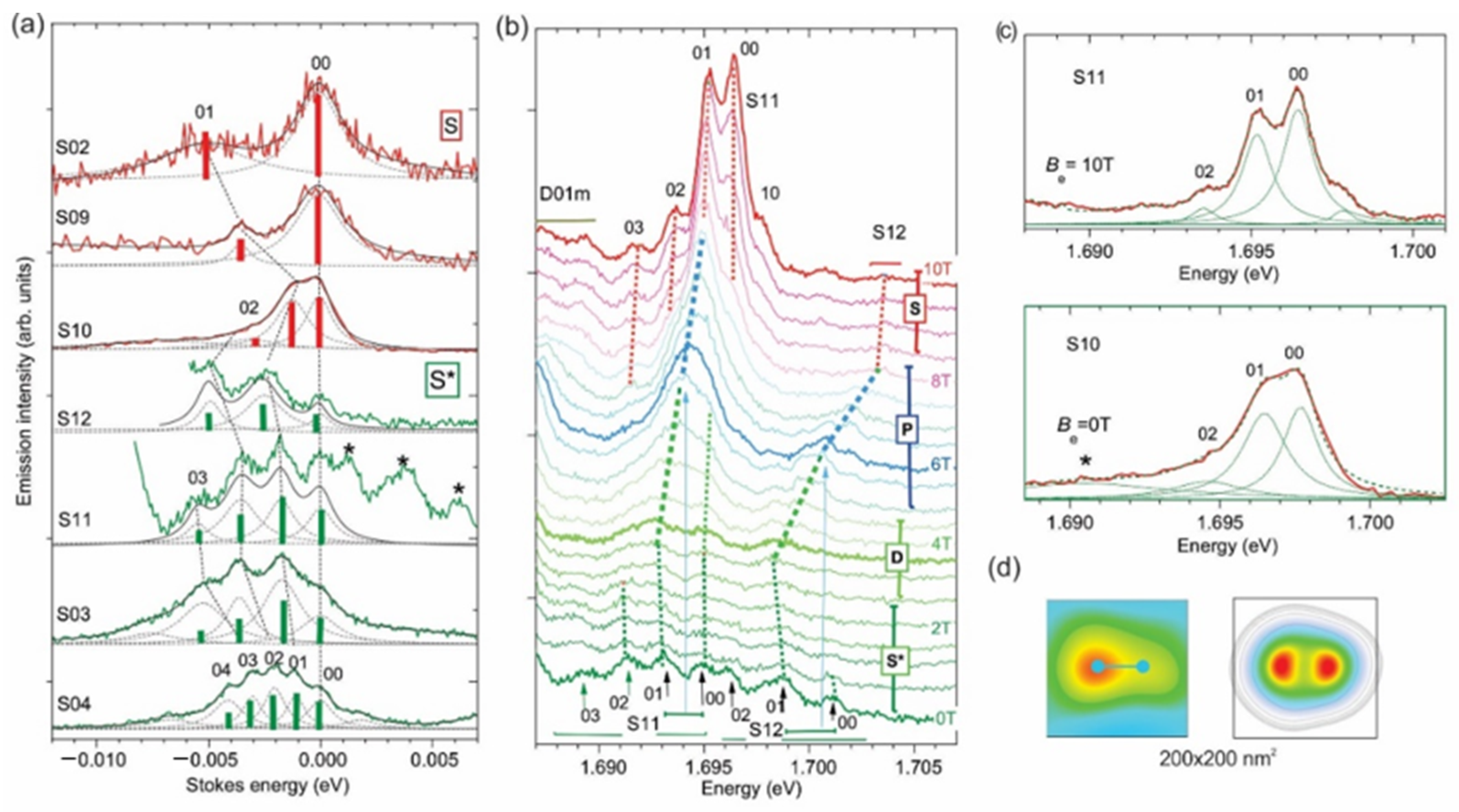
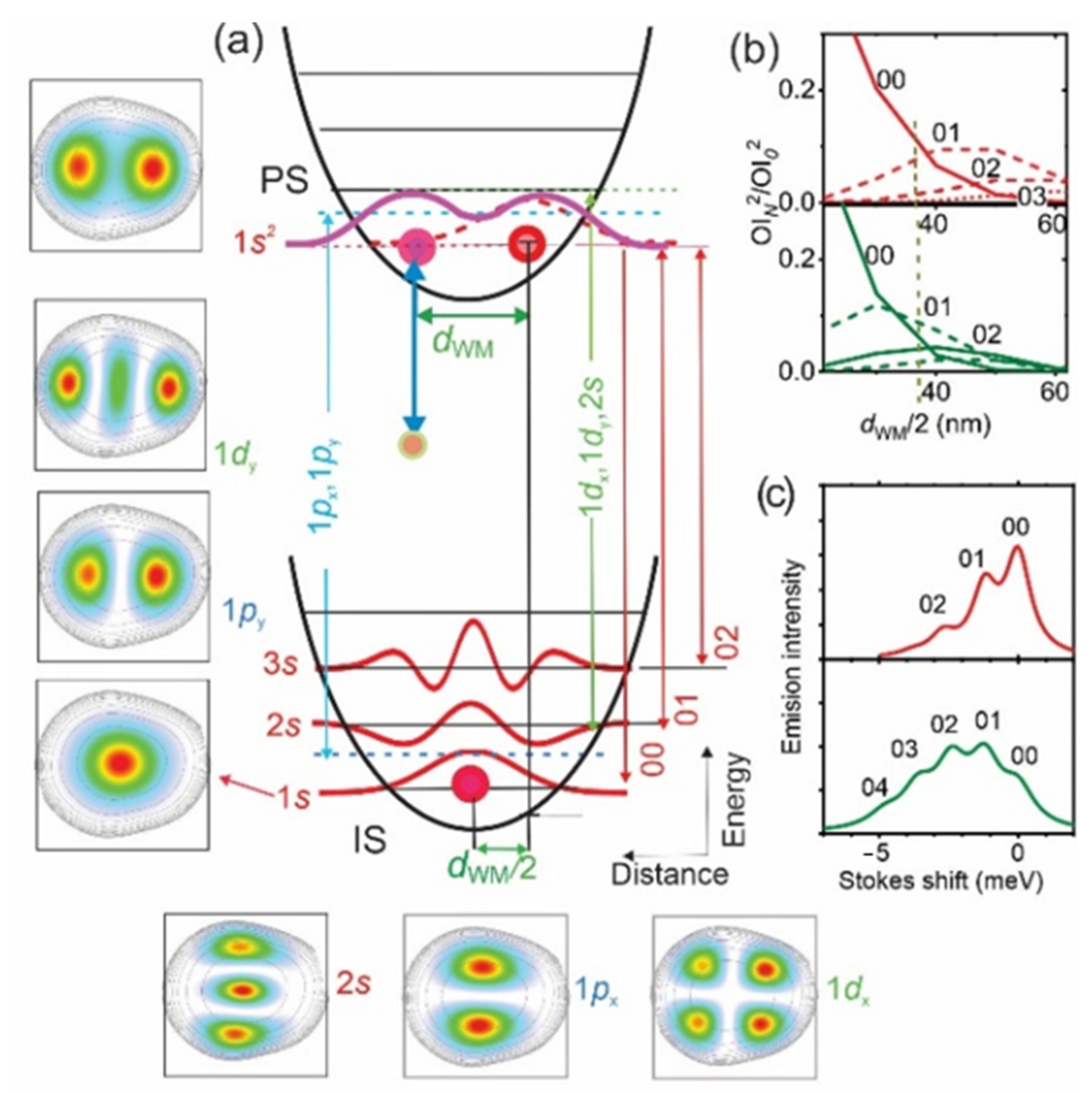
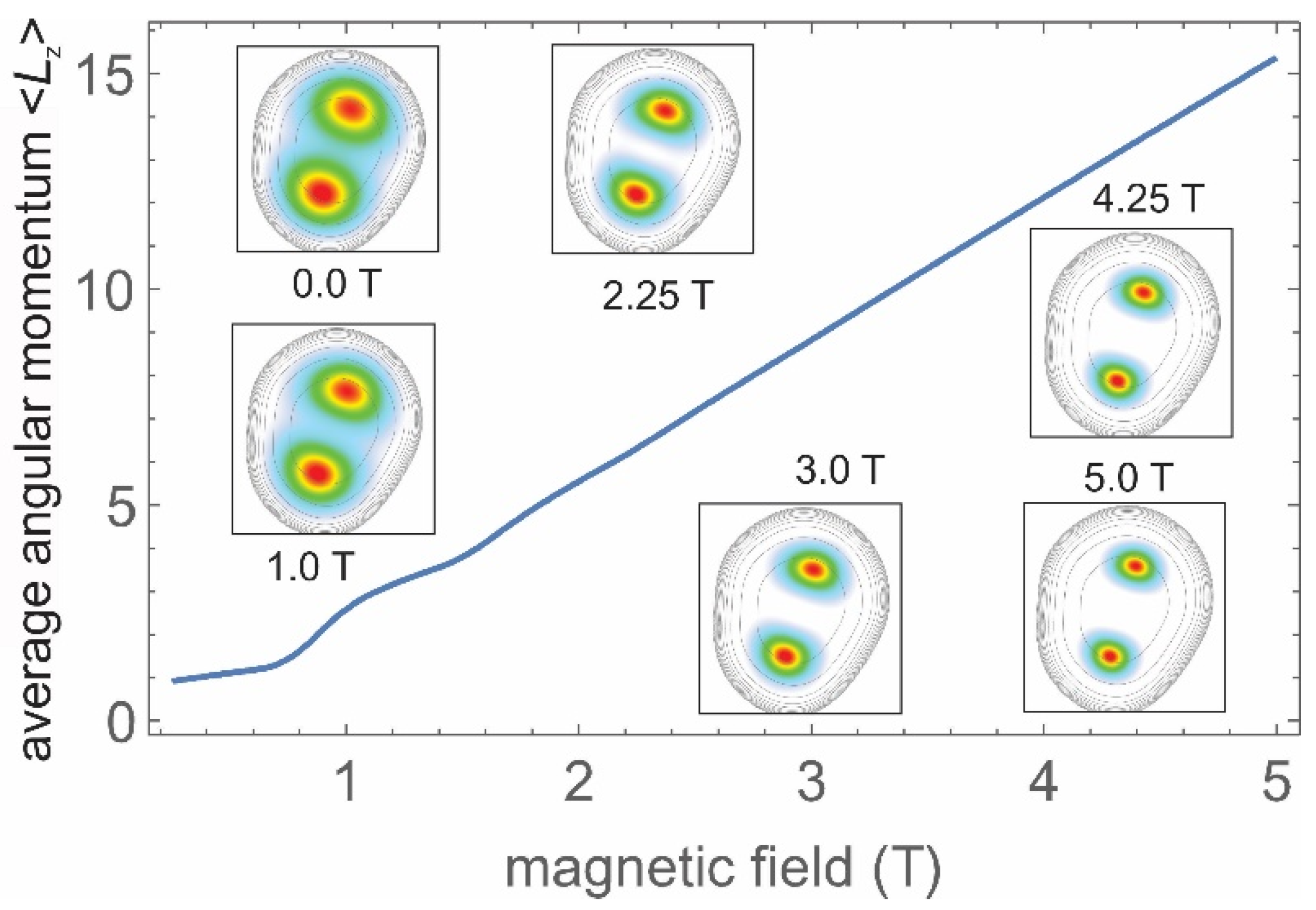
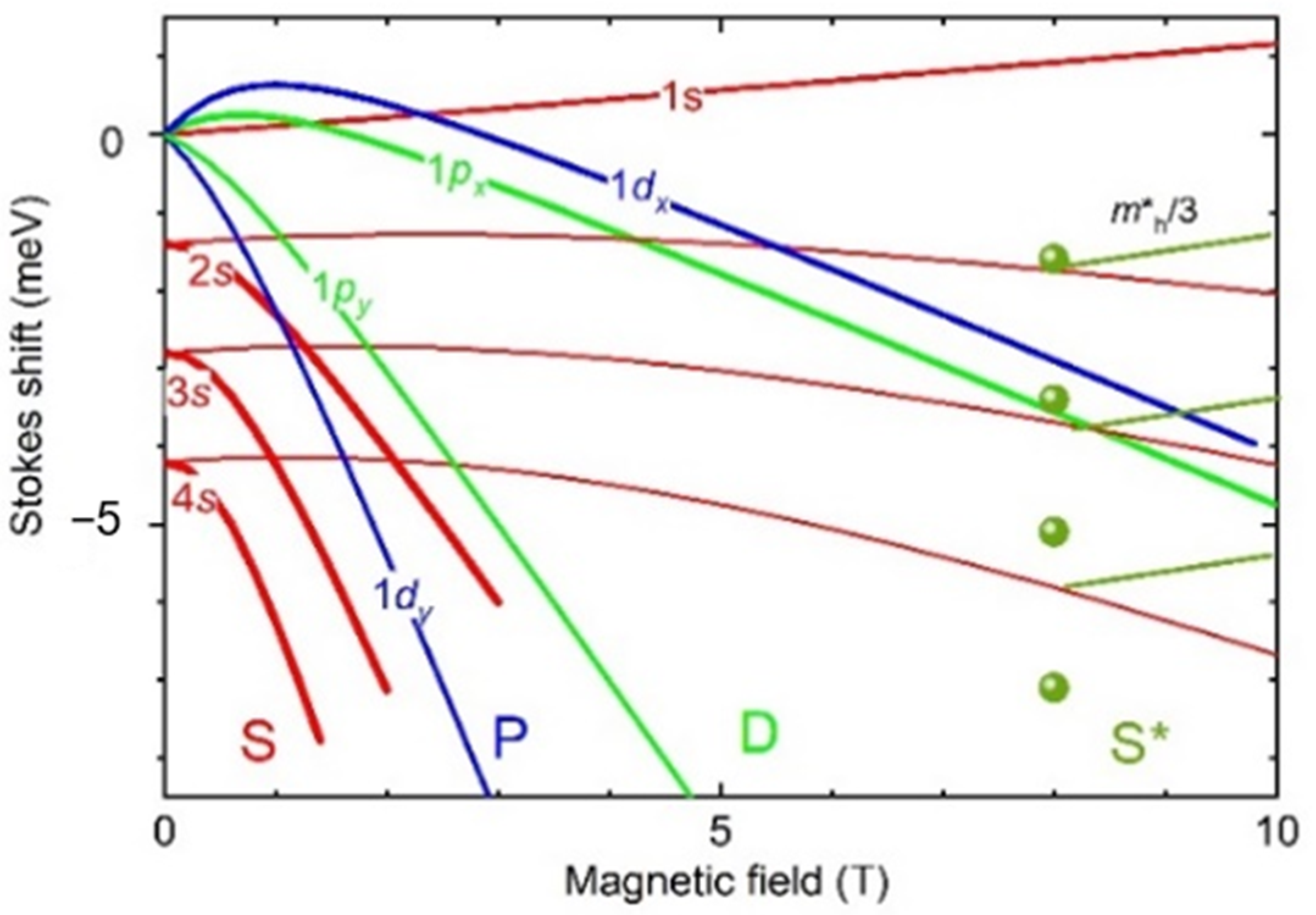

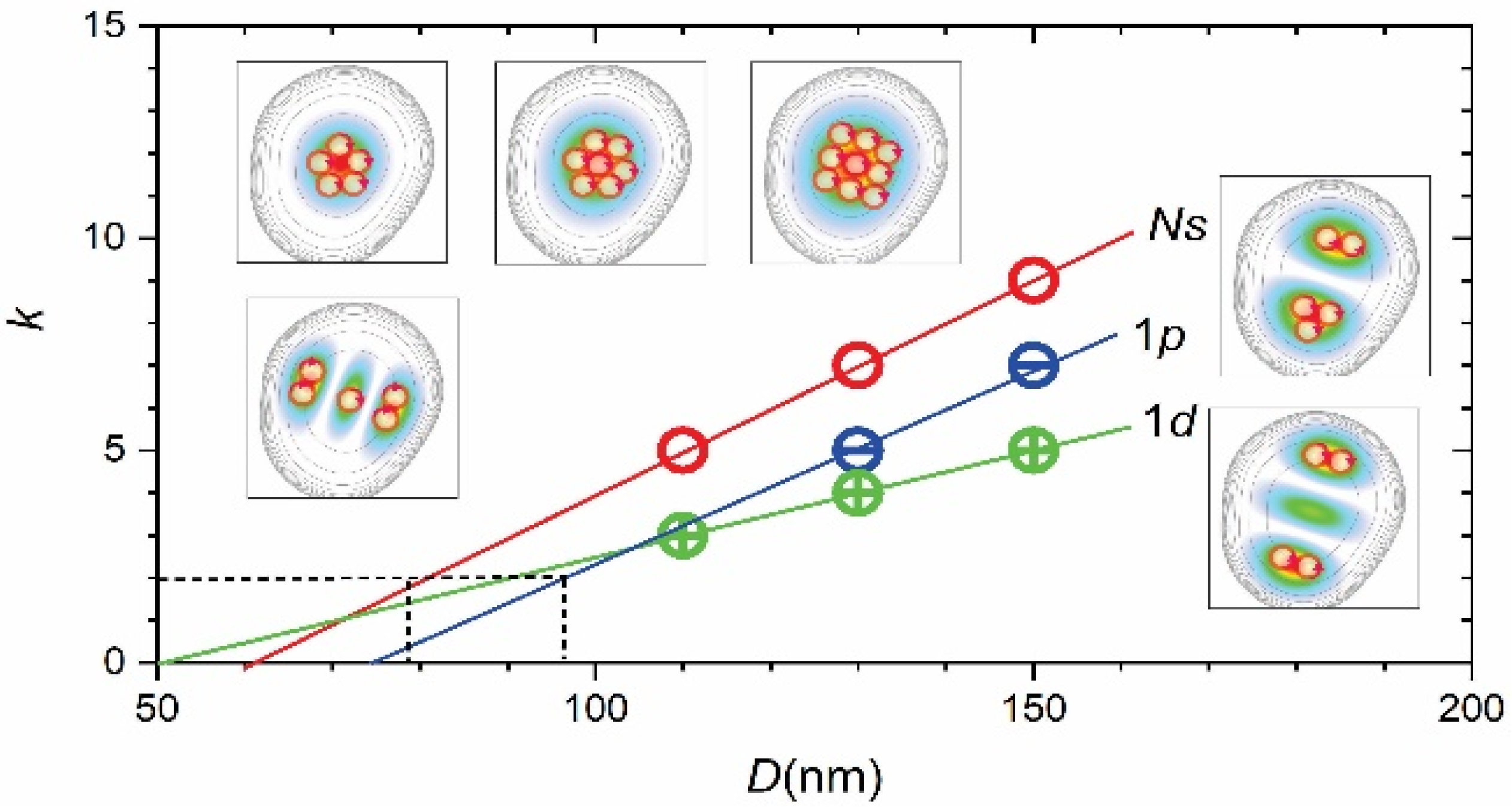
| No | Type | ħω0 (me) | D(a) (nm) | rs | E0 (eV) | xGa | dWM (nm) | Bbi T |
|---|---|---|---|---|---|---|---|---|
| S00 | trion | 4.0 | 60 | ~1 | 1.720 | 0.15 | - | 0 |
| S02 [25] | S | 2.5 | 85 | 2.5 | 1.724 | 0.15 | 35 | 0 |
| S09 [25] | S | 2.0 | 90 | 2.6 | 1.712 | 0.15 | 40 | 0 |
| S10 [25] | S | 0.7 | 140 | 4.1 | 1.798 | 0.2 | 75 | 0 |
| S12 | S* | 1.25 | 110 | 3.4 | 1.705 | 0.1 | 65 | 10 |
| S03 [25] | S* | 0.8 | 130 | 3.8 | 1.765 | 0.15 | 70 | 10 |
| S11 | S* | 0.8 | 130 | 3.8 | 1.695 | 0.1 | 70 | 10 |
| S04 [27] | S* | 0.6 | 150 | 4.3 | 1.743 | 0.15 | 80 | 15 |
| Quantum Dot | Dot Size D (nm) | Fractional Charge 1/k | ||
|---|---|---|---|---|
| N’s | 1p | 1d | ||
| S04 | 110 | 1/9 | 1/7 | 1/5 |
| S11 | 130 | 1/7 | 1/5 | 1/4 |
| S12 | 150 | 1/5 | - | 1/3 |
Publisher’s Note: MDPI stays neutral with regard to jurisdictional claims in published maps and institutional affiliations. |
© 2021 by the authors. Licensee MDPI, Basel, Switzerland. This article is an open access article distributed under the terms and conditions of the Creative Commons Attribution (CC BY) license (http://creativecommons.org/licenses/by/4.0/).
Share and Cite
Mintairov, A.; Lebedev, D.; Vlasov, A.; Bogdanov, A.; Ramezanpour, S.; Blundell, S. Fractional Charge States in the Magneto-Photoluminescence Spectra of Single-Electron InP/GaInP2 Quantum Dots. Nanomaterials 2021, 11, 493. https://doi.org/10.3390/nano11020493
Mintairov A, Lebedev D, Vlasov A, Bogdanov A, Ramezanpour S, Blundell S. Fractional Charge States in the Magneto-Photoluminescence Spectra of Single-Electron InP/GaInP2 Quantum Dots. Nanomaterials. 2021; 11(2):493. https://doi.org/10.3390/nano11020493
Chicago/Turabian StyleMintairov, Alexander, Dmitrii Lebedev, Alexei Vlasov, Andrey Bogdanov, Shahab Ramezanpour, and Steven Blundell. 2021. "Fractional Charge States in the Magneto-Photoluminescence Spectra of Single-Electron InP/GaInP2 Quantum Dots" Nanomaterials 11, no. 2: 493. https://doi.org/10.3390/nano11020493
APA StyleMintairov, A., Lebedev, D., Vlasov, A., Bogdanov, A., Ramezanpour, S., & Blundell, S. (2021). Fractional Charge States in the Magneto-Photoluminescence Spectra of Single-Electron InP/GaInP2 Quantum Dots. Nanomaterials, 11(2), 493. https://doi.org/10.3390/nano11020493






